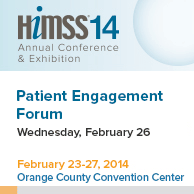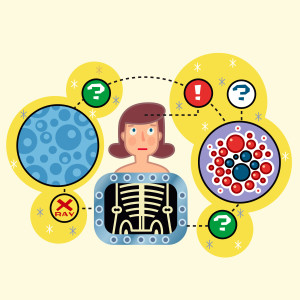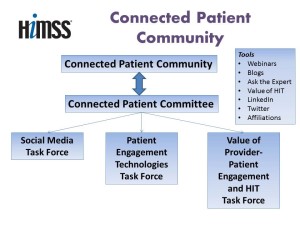 Even before stepping into the Orlando Convention Center on Sunday 23 February 2014, my clairvoyant powers know the forecast of the Best in Show: the growing role of patients in health care, reflected in both the education session at the annual 2014 meeting of HIMSS as well as the product/service mix being proffered on the convention show floor.
Even before stepping into the Orlando Convention Center on Sunday 23 February 2014, my clairvoyant powers know the forecast of the Best in Show: the growing role of patients in health care, reflected in both the education session at the annual 2014 meeting of HIMSS as well as the product/service mix being proffered on the convention show floor.
As a member of HIMSS Connected Patient Committee, I know first-hand the conscious effort and energy that the organization has committed to getting real about patients’-peoples’-caregivers’ central role in health care. The organization was built on providers and technology. When I first joined HIMSS nearly 20 years ago, the conference had a few thousand people (with proverbial pocket protectors) talking a lot about materials management, billing systems, and fax machines as networking technology.
This year, some 40,000 people will converge at OCC, and more conversations will be about patient engagement, activation, and self-care to help drive The Triple Aim. Underneath this is the explicit recognition and collective understanding that we must drive waste out of the health system and workflow, enhance quality and safety, and do more with less.
 The role of the health consumer — whom we define broadly as patient, person, and caregiver on our Connected Patient Committee — cannot be underestimated in helping drive that Triple Aim. Is your hospital dealing with managing readmissions? The patient and caregiver must be activated and involved in self-care and self-tracking of personal health data like weight, mood, food intake, and blood pressure. Is the CFO plagued with increasing bad-debt? People need to become the health consumers payors and providers need them to be to manage collections and support financial wellness for families. Are physicians newly-accepting the role of being accountable for payments, going at-risk for population health? Patients must be partners in shared decision-making, and in becoming more health-literate – and increasingly, health-plan literate when it comes to smartly using high-deductible health plans and HSAs.
The role of the health consumer — whom we define broadly as patient, person, and caregiver on our Connected Patient Committee — cannot be underestimated in helping drive that Triple Aim. Is your hospital dealing with managing readmissions? The patient and caregiver must be activated and involved in self-care and self-tracking of personal health data like weight, mood, food intake, and blood pressure. Is the CFO plagued with increasing bad-debt? People need to become the health consumers payors and providers need them to be to manage collections and support financial wellness for families. Are physicians newly-accepting the role of being accountable for payments, going at-risk for population health? Patients must be partners in shared decision-making, and in becoming more health-literate – and increasingly, health-plan literate when it comes to smartly using high-deductible health plans and HSAs.
 These three scenarios (among many others) illustrate the need for people, patients and caregivers to engage in health. Well-designed portals, mobile health apps, consumer-facing medical devices (like USB-enabled blood pressure monitors and glucometers, and smart pills and pill bottles ensuring medication adherence), can inspire and sustain peoples’ health engagement.
These three scenarios (among many others) illustrate the need for people, patients and caregivers to engage in health. Well-designed portals, mobile health apps, consumer-facing medical devices (like USB-enabled blood pressure monitors and glucometers, and smart pills and pill bottles ensuring medication adherence), can inspire and sustain peoples’ health engagement.
The Best in Show at #HIMSS14 will exemplify user-centered design and person-centeredness. Tech for tech’s sake is no longer tenable in this fiscally-constrained era.
To learn more about the connected patient, visit the Connected Patient Learning Gallery on the show floor (Hall A, Booth 2383) and attend Wednesday 26 February morning’s sessions #134, #152 and #179. Mine, “Putting the ‘P’ Ahead of HIT – It’s Personal,” will be bright and early at 830 am to kick off the morning providing a landscape of personal health IT, drivers and barriers for adoption featuring Dr. Danny Sands on health system and provider issues and Dr. Peter Hudson, developer of iTriage, talking about the “secrets in the sauce” for developing patient-centered health IT. And here’s the long list of over three dozen Patient Engagement sessions featured at #HIMSS14.





 Grateful to Gregg Malkary for inviting me to join his podcast
Grateful to Gregg Malkary for inviting me to join his podcast  This conversation with Lynn Hanessian, chief strategist at Edelman, rings truer in today's context than on the day we recorded it. We're
This conversation with Lynn Hanessian, chief strategist at Edelman, rings truer in today's context than on the day we recorded it. We're